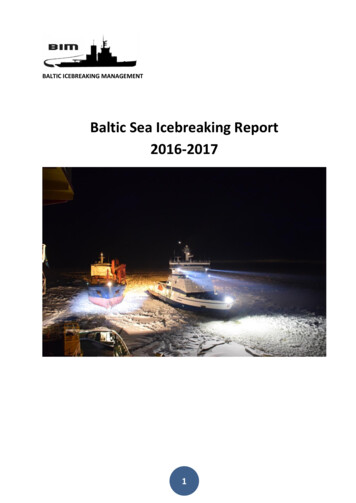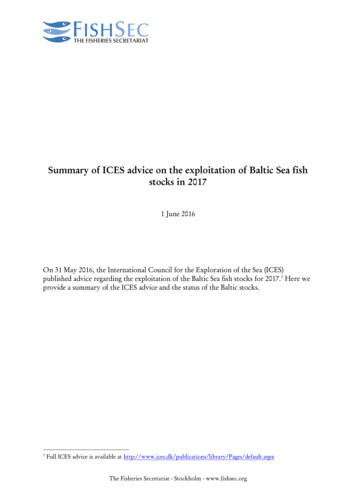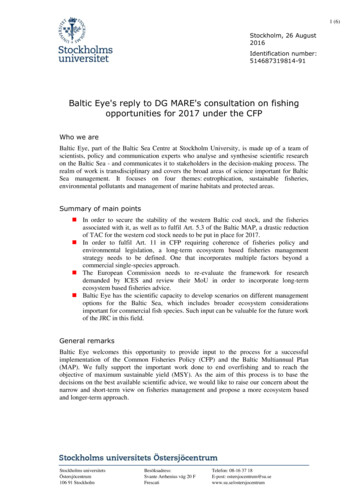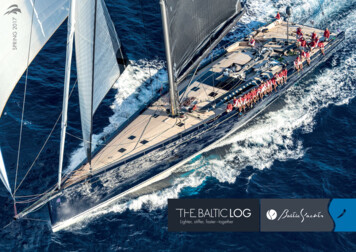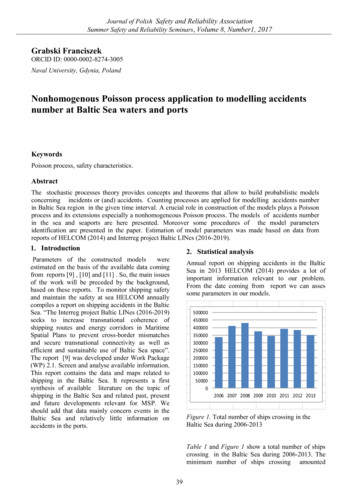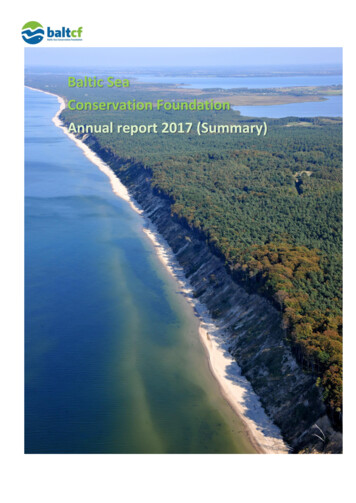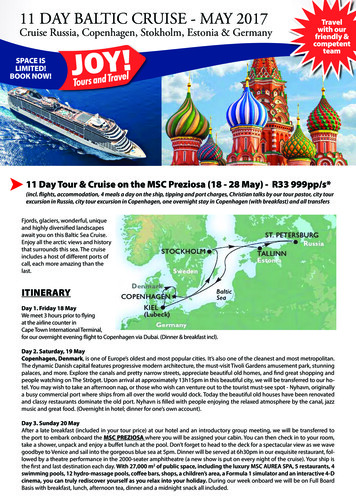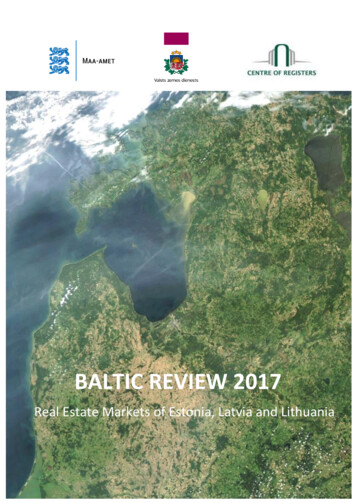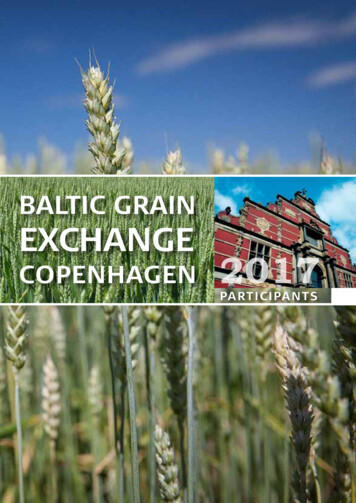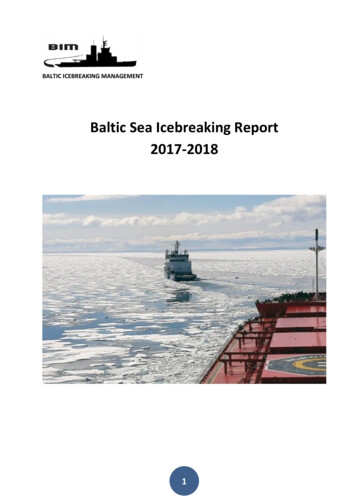
Transcription
BALTIC ICEBREAKING MANAGEMENTBaltic Sea Icebreaking Report2017-20181
Table of contents1.Introduction . 32. Overview of the icebreaking season (2017-2018) and its effect on the maritime transport system inthe Baltic Sea region . 43.Accidents and incidents in sea ice . 94.Winter Navigation Research . 95.Costs of Icebreaking services in the Baltic Sea . 105.1 Finland . 105.2 Sweden . 105.3 Russia . 105.4. Estonia . 115.5 Latvia, Lithuania, Poland and Germany . 115.6 Denmark . 115.7 Norway . 116.Winter navigation in the different parts of the Baltic Sea . 126.1 Bay of Bothnia . 126.2 Sea of Bothnia and the Quark . 126.3 Gulf of Finland . 136.4. Gulf of Riga . 136.5 Central Baltic . 146.6 Southern Baltic . 146.7 Danish waters, Swedish West coast, Germany and Norwegian waters . 157.Description of organizations and icebreakers engaged during the season 2017-2018 . 167.1 Finland . 167.2 Sweden . 177.3 Russia . 177.4 Estonia . 197.5 Latvia . 197.6. Lithuania . 197.7 Poland . 197.9 Denmark . 207.10 Norway . 208.Progress report of BIM (Baltic Sea Icebreaking Management) . 212
1. IntroductionBaltic Icebreaking Management, BIM is an organization with members from all Baltic Sea states. BIM is adevelopment of the annual meeting between Baltic Sea States icebreaking authorities which haveassembled since 1982. The member countries of BIM are Denmark, Estonia, Finland, Germany, Latvia,Lithuania, Norway, Poland, Russia and Sweden.After the difficult winter navigation season of 2002/2003 a project was started up within the framework ofHELCOM, aiming at improving the safety of winter navigation in the Baltic Sea. The HELCOMrecommendation 25/7 on the safety of Winter Navigation in the Baltic Sea Area was adopted in March2004.Within the EU concept Motorways of the Sea, which is one priority project in the trans-European network,the Baltic Sea countries established a working group with the aim of creating more efficient winternavigation by cooperation between the Baltic Sea countries. The icebreaking authorities around the BalticSea decided in Helsinki meeting 2004 that this work shall continue within the framework of BIM, where alsonon EU-member states are taking part. BIM should function all year round and its strategy should be todevelop safe, reliable and efficient winter navigation between the Baltic Sea countries. The overall objectiveof BIM is to assure a well-functioning maritime transport system in the Baltic Sea all year round byenhancing the strategic and operational cooperation between the Baltic Sea countries within the area ofassistance to winter navigation.On 10 January 2007, the Joint Baltic web service on winter navigation www.baltice.org was launched. On17 June 2015, a new version of the Joint Baltic web service on winter navigation was launched.On 11 April 2007, the DVD of training in ice navigation for seafarers was launched.On 15 November 2007, HELCOM adopted a new recommendation 28E/11 outlining further measures toimprove the safety of navigation in ice conditions in the Baltic Sea; BIM was acting an “ice advisor” in thisrecommendation.In 2008 the pamphlet “The World Icebreaker, Icebreaking Supply and Research Vessel Fleet” was presentedand updated in 2011.In April 2009, a computer based training program, based on the DVD, was introduced. After completing thecourse, the student gets a certificate over earned skills. One important task of BIM is to inform stakeholdersin the maritime sector and policy makers about winter navigation and icebreaking. There is a need forinformation about winter navigation and icebreaking that covers the whole Baltic Sea region.Several Baltic Sea countries prepare information about the winter navigation and icebreaking in theirrespective national waters. There has been a need to coordinate this country-specific information, improvethe information and to distribute it to a wider target group by “Joint Annual Baltic Icebreaking Report”.This report gives an overview of the winter navigation season 2017/2018 for the Baltic Sea area. Nationalreports can be found on the site www.baltice.org . The report will also describe organizational changes inthe icebreaking authorities or changes in icebreaking resources and provide a progress report of the BalticSea Icebreaking cooperation and the development of BIM.3
2. Overview of the icebreaking season (2017-2018) and its effect onthe maritime transport system in the Baltic Sea regionAccording to the Finnish Ice Service of the Finnish Meteorological Institute the Baltic Sea ice season 20172018 was average. The maximum ice extent, 175 000 km², was reached on 5 March.Figure 1. The maximum ice extent of the ice season 2017-2018 was reached on 5 March 2018.4
The freezing started from inner bays of the Gulf of Bothnia in early November. December was warm and atthe end of December, the extent of sea ice was only 13 000 km². Icebreaker ALE started her assistance workon 7 December.In January and early February the area of ice increased in a regular manner. In mid-February, the weatherchanged clearly - cold weather hit the Baltic Sea region. Cold weather continued at the beginning of Marchand the peak of the ice winter was reached on 5 March, when the ice extent was 175 000 km².Figure 2. The development of ice season 2017-2018 compared to seasons 2006-2018.In March the weather continued to be cold, but at times windy. At the end of March the extent of the icewas 115 000 km².April was warmer than usual and ice melting accelerated. At the end of April the extent of ice was 35 000km². May was clearly warmer than average and the Baltic Sea was ice free on 20 May.Ice conditions in the eastern part of the Gulf of Finland in 2017-2018The ice formation processes in the winter of 2017/2018 were those of a mild winter. Ice formation in thecoastal shallow zone of the eastern part of the Gulf of Finland began in the third decade of December 2017.By mid-January, the entire water surface of the seaport “Big port of Saint-Petersburg” was completelycovered with ice, the thickness of which was from 5 to 15 cm. Young ice spread to the west of the Meridianof the Cape Shepelevsky. In the northern part of Vyborg Bay lay fast ice. By the end of January, the icesituation had not changed.5
February was the coldest month of the winter of 2017-2018. Air temperatures in some areas dropped tominus 26-27 degrees, so intense ice formation occurred at this time. At the end of the second decade ofthe month, drifting solid ice, 15-20 cm thick, spread to the meridian of island Hogland. The whole waterarea of Neva Bay and Vyborg Bay was covered with fast ice.The most difficult ice situation developed by the beginning of March. The drifting cohesive ice of a thicknessof up to 20 cm spread to the Meridian of the port of Tallinn. For ships, the most difficult places were thesection of the Bolshoy Korabelnyy Fairway and the closed part of the St. Petersburg Sea channel in the areaof the Neftyanaya Gavan, where the thickness of the ice edge of the channel reached 2 metres. The waterareas of the seaports Ust-Luga and Primorsk were completely ice-covered; the thickness of ice reached 3035 cm. In the third decade of March, daytime temperatures approached zero and ice formation sloweddown. The site of the Big Ship fairway was practically cleared of ice. However, the waters of the ports wereunder cohesive and soldered ice, the thickness of which reached 25-40 cm.In April, intensive destruction of the ice cover began. By 18 April, the water area of Neva Bay was clear ofice, and on 24 April the waters of all Russian ports in the eastern part of the Gulf of Finland were completelyice free.The maximum thickness of fast ice was 30-70 cm in the Bay of Bothnia, 30-45 cm in the Sea of Bothnia and25-50 cm in the Gulf of Finland. The thickness of pelagic ice was 40-60 cm in the Bay of Bothnia and 20-45cm in the Gulf of Finland.Figure 3. The maximum ice coverage in ice winters 1961-2018. The average of 1961-2011 (51 years) is187 000 km². Severities of the season are indicated using colours from mild to severe (lightest blue todarkest blue respectively).6
For safety reasons, the Baltic Sea countries have agreed within HELCOM on a joint policy when trafficrestrictions are issued. For efficiency reasons, the icebreaking authorities can demand a lowest limit onvessels’ engine power as well. Smaller vessels like buoy tenders and tugs with strong engines and hull areused as port icebreakers and for icebreaking mission in waters protected from drifting sea ice. In open seaareas that are affected by drifting sea ice with ridges and ice pressure, big sea icebreakers are required.Total number of icebreakers inoperation in .18w.19w.20w.21w.22w.230Sea Icebreakers (more than 7500 hp)Other IcebreakersTotal IcebreakersFigure 5. The total number of icebreakers in operation each week in the Baltic Sea during this season.According to statistics from the Baltic Sea icebreaking authorities, 4980 vessels received assistance fromicebreakers this season.7
Assisted ships29129726291763Gulf of FinlandBay of BotniaSea of BotniaGulf of RigaFigure 6. A total of 4980 vessels where assisted by icebreakers during the icebreaking season 2017-2018in the Baltic Sea.The longest sailing distance in sea ice is to the northernmost ports in the Bay of Bothnia. But due to the bignumber of vessels in the shorter fairway to the easternmost ports in the Gulf of Finland, the traffic is moreaffected by sea ice in this area, especially during periods with strong westerly winds when the icebreakersmust tow many vessels one by one.8
Figure 7. Sailing distance from ice edge during maximum ice extension on 5 March 2018: to Kemi 323nautical miles, to St. Petersburg 185 nautical miles and to Riga 118 nautical miles.3. Accidents and incidents in sea iceThe Technical University of Helsinki collects information on accidents related to navigation in ice. Shipowners and others within winter navigation are requested to report accidents, incidents and damages thatare ice-related to icedamage@tkk.fi or toIce Damage DatabaseHelsinki University of TechnologyShip Laboratory9
PL 530002151 TKKFINLAND4. Winter Navigation ResearchWinter navigation research is carried out in co-operation between Finland and Sweden. Funds for researchprojects are allocated by the Winter Navigation Research Board, which consists of representatives of theFinnish Transport Agency, Finnish Transport Safety Agency, Swedish Transport Agency and SwedishMaritime Administration. Published research reports can be found on kaisut/talvimerenkulun tutkimusraportit).5. Costs of Icebreaking services in the Baltic Sea5.1 FinlandIn Finland the stand-by and operational costs of icebreakers were nearly 54 million euro in the period 20172018. Bunker costs were 7.15 million euro. This season started like a mild winter, but it gained rapidly moreice in mid-January; then there was a short mild period and the ice formation started again in mid-February.According to the Finnish Ice Service of the Finnish Meteorological Institute the Baltic Sea ice season 20172018 was average. The maximum ice extent, 175 000 km², was reached on 5 March. The winter lasted until21 May when IB Kontio moored to Helsinki. The total number of operating days was 756. The FinnishTransport Agency (FTA) used all nine contracted icebreakers during the season – for the first time since the2012-2013 season. The abovementioned costs include all FTA chartered seagoing icebreakers. The FTA hasalso contracts with private tugboat companies for minor operations. The total costs of the Finnishicebreaking services are normally around 60 million euro depending on the winter.5.2 SwedenIn Sweden the cost for the stand-by period for our own icebreakers was approximately 11.5 million euro,additional operational costs were 8.5 million euro, and fuel costs 5.7 million euro. The total cost for theSwedish icebreaking services including external recourses varies from 20 to 40 million euro, depending onthe severity of the winters. The costs this winter were estimated to be 30.9 million euro. This is thegovernment’s costs; costs for the different ports and industries are not included.5.3 RussiaIn accordance with the orders of the FTS of Russia dated 20 December 2007 No. 522-t/1 and 18 November2014 No. 262-t/5, and by order FAS of Russia of 06 June 2016 No. 711/16, new rates of icebreaking dues inthe Russian ports of the Gulf of Finland are established as follows:Icebreaking dues:1. Icebreaking dues are applied for coming in, coming out or transiting the port area.2. For the cargo ships engaged in liner services, which are officially declared, the factor of 0.8 is applied tothe rates of the icebreaking dues.From icebreaking dues are exempted:10
- vessels of ice class ARC7 (according to classification of the Russian Maritime Register of Shipping or classesof other classification societies corresponding to it);- passenger vessels.Upon the announcement by the Harbour Master of winter (summer) navigation before the target date, andalso after the prolongation of its duration, icebreaking dues are paid as per corresponding rates from thedate of announcement to a date of completion (inclusive), corresponding to the period of winter navigation.Rates for ships engaged in an international trade rub/1 GT (for Bolshoy port of Saint-Petersburg)The summer ratefrom 01 May to 30NovemberThe winter ratefrom 01 Decemberto 30 AprilAll vessels exceptRo-Ro, Ro-Flow,container ships andtankers6.65Container shipsRo-Ro, g the period from 01 May to 30 November, the following vessels are exempted from payment oficebreaking dues: arriving at the port from inland waterways of Russia or from the Saimaa canal and sailing back withinthe current year; arriving at the port from other Russian ports situated in the eastern part of the Gulf of Finland.During the period from 01 December to 30 April, the vessels with ice class ARC5 and ARC6 (according toclassification of the Russian Maritime Register of Shipping or classes of other classification societiescorresponding to it) are subject to icebreaking dues multiplied by factor 0.75.5.4. EstoniaIn Estonia, the total cost of icebreaking in the 2017-2018 season amounted to approximately 6.2 millioneuro, with about 600 000 euro accounting for the costs in the Pärnu Bay and 5.6 million euro for the Gulfof Finland. This is the Governmental costs.5.5 Latvia, Lithuania, Poland and GermanyIn Latvia no special fee is collected for icebreaker services. The operational costs of icebreaker services werearound 435 000 euro for the 2017-2018 winter period. This includes bunker and crew costs, but excludesicebreaker maintenance costs.There was no cost information for icebreaking operations in the season 2016-2017 for Lithuania, Polandand Germany.5.6 DenmarkNo icebreaking operations in the 2017-2018 season.5.7 NorwayNo information; there were no icebreaking operations in the 2017-2018 season.11
6. Winter navigation in the different parts of the Baltic Sea6.1 Bay of BothniaTraffic restrictions where initiated on 19 December in the Bay of Bothnia; the icebreaking operations began on 18 December when IB Kontio was ordered to startthis year’s icebreaking.The first assistance of the merchant vessels was conducted on 26 December.When the ice extension was at its peak in week 10, there were 6 liner icebreakersin operation at the same time.Assistance activity went on from 26 December to 15 May. During this winter 1763vessels were assisted in the Bay of Bothnia.The highest level of ice restrictions IA and 4000 dwt with cargo restriction 2000t were reached on 6 Marchin the northern and on 24 February IA and 4000 dwt in the southern parts. The icebreaking season endedin the Bay of Bothnia on 23 May when the last restrictions were cancelled. IB Kontio was the last icebreakerto leave the Bay of Bothnia.Assistance was conducted to the following KemiOuluRaaheKalajokiKokkolaPietarsaari6.2 Sea of Bothnia and the QuarkTraffic restrictions where initiated in the area on 10 January.The highest level of ice restrictions IA and 3000 dwt were reached on 3 March inthe northern and on 3 March IA and 2000 dwt in the southern parts. Theicebreaking season ended in the Bay of Bothnia and the Quark on 4 May when thelast restrictions were cancelled in Vaasa.During this winter 297 vessels were assisted in the Sea of Bothnia and the Quark.12
6.3 Gulf of FinlandFor the Finnish parts of Gulf of Finland, the first traffic restrictions I, II 2000were initiated on 27 January in Kotka, Hamina and Loviisa. The highestrestrictions were raised to IA, 2000 in the abovementioned ports on 4 March.All restrictions were cancelled on 22 April. There were 3 icebreakers operatingin the Gulf of Finland. During the winter there were 184 ships assisted in theFinnish part of the Gulf of Finland.The first traffic restrictions were imposed on 12 January 2018 in St. Petersburg.The restrictions were cancelled on 25 April 2018. All vessels which neededicebreaker assistance were bound for Russian ports. During the largest ice cover, the Russians had six sea(liner) icebreakers and six minor (port) icebreakers in use. The icebreaking season lasted from 25 December2017 to 25 April 2018 in the Russian territorial water.During the winter 2393 ships were assisted on their way to or from the Russian ports.Assistance was conducted to the following ports:VyborgPrimorskUst-LugaSillamäeVysotskSt. PetersburgHaminaKundaFor the Estonian part of the Gulf of Finland traffic restrictions were imposed from 1 March 2018.Restrictions were cancelled from 12 April 2018. IB Botnica and IB Tarmo assisted 52 ships to and fromEstonian ports in the Gulf of Finland.During the winter 2629 ships were assisted in the Gulf of Finland.6.4. Gulf of RigaThe Estonian Meteorological and Hydrological Institute assessed the winter of2017-2018 as normal. Traffic restrictions were initiated on 27 January (IC, 1600kW) in Pärnu. On 12 April traffic restrictions were cancelled. The icebreakingseason lasted from 8 January to 28 March, and 148 ships were assisted by themulti-purpose-vessel EVA-316 and the tug Protector.In the winter of 2017-2018 the Harbour Master of Riga declaredcommencement of ice navigation starting from 25 February and it was in forceuntil 4 April, meaning that ice navigation regulations and traffic restrictionsapplied to all vessels visiting the port of Riga. Actual icebreaking operations in the Gulf of Riga and the IrbeStrait began on 1 March when IB Varma was ordered to sail out to the Irbe Strait and commence service.The last icebreaking assistance was carried out on 30 March and the Varma returned to her berth in Rigaon 3 April. In total, the Varma assisted 118 ships in 32 days, sailed around 2300 nautical miles and used 326tons of bunkers. No damages, incidents or accidents were reported related to navigation in ice.Assistance was conducted to the following ports:13
PärnuRigaThe total number of ships assisted in the Gulf of Riga was 291.6.5 Central BalticIn Swedish waters restrictions were initiated from 27 February to 23 March fromGrisslehamn - Bergkvara. The buoy tender vessel Baltica assisted five vessels toports in the Kalmar sound.6.6 Southern BalticEast Coast Area. Ports of Gdańsk and GdyniaThere were no significant difficulties for shipping caused by ice. The ice on innerwaters of the ports was easy to break by berthing / unberthing vessels.The icebreaking action was announced only for inner waters of Gdansk harbourfrom 28 February to 8 March.There was no need to engage icebreaking tugs on the approaches to the ports.West Coast Area. Ports of Szczecin and ŚwinoujścieI. Winter seasonRegarding temperatures the months of November and December 2017 were mild, with the meantemperatures 7 and 5 degrees above zero. January 2018 was a little colder; occasionally the temperaturedropped below zero. February 2018 was definitely cold, with some days – the last week – with constantminus degrees, up to 11 degrees below zero. The mean temperature for February was 0.1 degrees. At thebeginning of March the temperatures were down to 11 degrees below zero, but the following days werewarm, the temperature occasionally rising to 16 degrees.The first ice formation appeared on 26 February 2018. It was a 100% coverage of ice with a thickness ofabout 5 cm in the area within the ports of Świnoujście and Szczecin. In the beginning it was no obstacle tonavigation. The navigation in the area was more difficult a little later when ice became thicker, about 10cm, and due to the winds the ice became a little ridged and heaped up and obstructed traffic to a certainextent. When in March the warm days began ice started to melt very quickly. On 16 March 2018 icedisappeared and water was free of ice in the area.II. Actions14
1. Putting into force ice restrictions by the Harbour Master of Swinoujście / Szczecin, in their area ofresponsibility:- The first restriction was put into force on 26 February 2018 and it was said that the main fairwaySwinoujście-Szczecin and the ports of Swinoujście and Szczecin were not available for wooden and laminatesmall vessels. This restriction was suspended on 16 of March 2018.- From 28 February to 13 March 2018, the main fairway Świnoujście-Szczecin and the port of Szczecin wereavailable for vessels with ice class L-4 PRS (or an equivalent class of another Classification Society) and mainengine power above 1200 KW.2. Special statements of the Harbour Master of Świnoujście/Szczecin.Statements issued by the Harbour Master of Szczecin:- From 1 March 2018 to 12 March 2018 – one-way traffic was established on the water fairway betweenGate No. I and Gate No. IV.3. Icebreaking actions:Generally, when there were ice formations, traffic was organized in convoys as one-way traffic.Summary1. In the thermal aspect – the winter season 2017-2018 can be defined as gentle and causing somedifficulties to navigation.2. In the ice condition aspect – the winter season was not difficult, ice formation was not a serious obstacleto navigation.There were no difficulties for shipping caused by ice. The ice on inner waters of the ports was easy to breakby berthing / unberthing vessels. There was no need to engage icebreaking tugs on the approaches to theports.6.7 Danish waters, Swedish West coast, Germany and Norwegian watersNo restrictions were issued to Swedish ports.GermanyThere was only sporadic icebreaking in the inshore waters.15
7. Description of organizations and icebreakers engaged during theseason 2017-20187.1 FinlandThe Finnish Transport Agency (FTA) is the national authority responsible for the assistance of winternavigation, its coordination, development and management nation-wide. The actual icebreaking serviceshave been contracted out.The FTA develops Finland’s icebreaking policy, taking into account the requirements of its clients (mainlythe Finnish industry). Essential for the industry are as short waiting times as possible for traffic. The FTAdecides on the length of the assistance period, exemptions and traffic restrictions. Traffic restrictions arenormally made more stringent than the minimum HELCOM safety recommendations, as the objective is,besides safety, to assure an efficient and safe maritime traffic flow. Only vessels fulfilling the criteria of dailytraffic restrictions are given assistance.The icebreaking services are procured mainly from Arctia Icebreaking Ltd., Alfons Håkans AS and also fromother companies for minor operations. Minor operations are mainly tugboat services for icebreaking in lightice conditions in harbour entrances and in Lake Saimaa. FTA’s winter navigation unit in general and VTScentres and specific area coordination IB masters locally are responsible for the management and dailyoperation of the icebreaking services to all assisted ports.The main KPI is that vessels should not have to wait for an icebreaker for more than 4 hours on an average.Another goal for the Finnish icebreaker service level is that 90 % to 95 % of vessels navigating in the ice fieldcould sail through without waiting for icebreaker assistance. The average icebreaker waiting time for allFinnish sea areas in this season was 4.28 hrs and 95 % of all port calls did not have to wait for icebreakerassistance at all.In Finland no special fee is collected for icebreaker services. All ships pay fairway dues based on ship sizeand ice class. The fairway dues are used to cover the costs of fairway maintenance and icebreaking services.A State agreement between Sweden and Finland has further developed the co-operation in winternavigation activities between these two countries for a decade. Optimal usage of “common” IB resourceslowers total costs and grants more reliable service to customers.Icebreakers engaged by the Finnish Transport Agency eakerIcebreakerIcebreakerPropulsion power16 200kW16 200kW19 000kW15 000 kW15 000 kW15 000 kW10 200 kW16
ZEUSTHETIS (substitute for ZEUS)IcebreakerIcebreaker6 000 kW8 004 kW7.2 SwedenIcebreaking operations are managed by the Icebreaking Management of the Swedish MaritimeAdministration in Norrköping and are based on the Swedish icebreaking regulation (2000:1149). It allocatesicebreakers to work areas, issues traffic restrictions, monitors the operational situation and informs theshipping stakeholders of ice conditions and the traffic situation. Sweden controls six icebreakers, of whichthe Swedish Maritime Administration owns five and has one on long-term charter from a private shipowner. All Swedish icebreakers are manned by a private shipping management company.Sweden and Finland use a jointly developed IT based on-line system, IBNet (Icebreaker Net) for coordinationof the joint icebreaking operations. It contains information about the weather, ice conditions and trafficsituation, and transmits the info
the maritime transport system in the Baltic Sea region According to the Finnish Ice Service of the Finnish Meteorological Institute the Baltic Sea ice season 2017-2018 was average. The maximum ice extent, 175 000 km², was reached on 5 March. Figure 1. The maximum ice extent of the ice season 2017-2018 was reached on 5 March 2018.
